Shortest Day, Hardest Drive
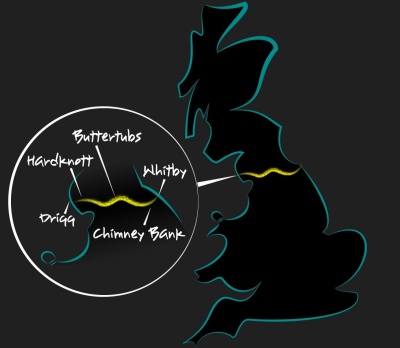
Between Whitby on the east coast and Drigg on the west coast of England lie the North York Moors, the Yorkshire Dales and the Lake District. Or to put that in driving terms: Chimney Bank, Buttertubs and Hardknott. Goosebumps.
On the summer solstice we drove from the most easterly point of England to the most westerly point of Wales, sunrise to sunset in 17 hours or so. Now, on the shortest day of the year, we again raced the sun coast to coast - this time seven and a half hours of hard driving. Why hard? Chimney Bank and Hardknott Pass are the steepest roads in the country, and Hardknott is often called the most difficult, while Buttertubs is a said to be a test of skill. And let's not forget the weather in late December in Northern England: cold rain, fog, snow, wind, and more cold rain. And then remember this will be driven in an Ariel Nomad. Never mind hardest, this might be the best.
We started in Whitby, which skilfully mixes trashy seaside amusements with an eerie vampire vibe. This is where Dracula attacked Lucy at the top of the 199 steps to the ruined abbey, a good place to loiter on a dark December night. The next morning the sun probably rose over the North Sea but the clouds were thick and low so we waited for 8:23 and then began. The idea had been to start at the end of the east pier and, in the spirit of the Le Mans start, run to the Nomad. Unfortunately the Nomad was parked by the abbey so the run included those 199 steps and what started as a sprint ended as a stagger. Then we were away, out of Whitby, through Egton Bridge and onto Smith's Lane.
Smith's Lane crosses the North York Moors that are wonderful at any time of year, but spectacular in winter in a car with no roof, sides or heating. Smith's Lane runs to Rosedale, unremarkable in itself but the road out is Chimney Bank, joint steepest in England. The steep bits are near the bottom on sharp right then left corners. The rest of the hill is steep but not difficult and there's a car park at the top for a short pause to admire the moors or explore the ironstone kilns. Then on to Hutton-Le-Hole, which is known as a pretty village but I confess did nothing for me. It's also known for the sheep that wander around it, but there were none about so there was nothing to delay us and we kept on to Rievaulx. Rievaulx Abbey had a good run from 1132 until Henry VIII nicked it during the dissolution of the monasteries in 1538. Now it's a picturesque ruin in a pretty valley, but without Whitby's brooding menace.
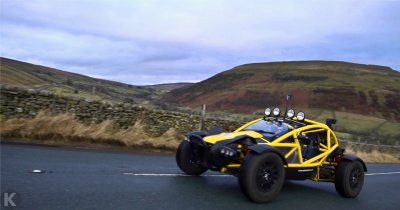
Next up was Buttertubs Pass, one of the most enjoyable roads in the country, but to get there took fifty miles of sprints between small towns. Much of it was fun but there's no room to overtake for most of this section so if we were unlucky with the traffic or weather we would lose our race with the sun. By the time we got to Muker we were behind but hadn't lost hope.
Buttertubs, or Cliffgate Road, is a turning on the B6270 between Muker and Thwaite. It starts innocuously but by the first proper left-hander is clearly special and when the stone wall became a skinny wire showing the drop into the valley it would have taken surgery to remove my grin. There are no steep hills or tight bends, but pick the right line and it's joyous. By the top of the climb I was catching a car and for a moment I thought I'd be stuck, but it kindly pulled over and I could zip across the top with its curving undulations, the Nomad suspension doing its thing. As the road drops the view of the dales is stunning but if you want to admire it go back a second time.
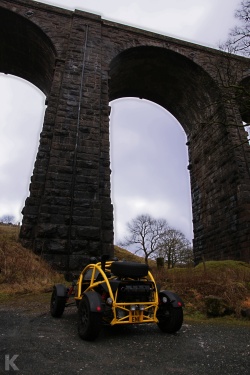
Our next stop was Dent Head viaduct on the spectacular Settle to Carlisle railway, though sadly steam trains don't run in winter. Dent is not as long or famous as the Ribblehead viaduct but you can drive through it and it's a good lunch stop. Here our weather-luck ran out and it started to rain true Yorkshire rain, hard and cold and unrelenting; Dent has four times London's annual rainfall and we got most of it. As we drove towards Kendal I was flexing my hands and wriggling my toes to ward off frostbite, but by the time we got there about an hour later at least the rain had stopped.
Kendal had blurred into wet grey and I was happy to escape to Windermere where, for a short section, the road hugs the side of the lake. Lake District roads are diabolically slow in summer but I hoped to get a clear run on such a bleak mid-winter day, but no. Our route took us around the northern end of the lake, across the Brathay at Skelwith Bridge and along the A593 to the turning to Wrynose. I was suprised by how many cars took the road to Wrynose but gradually they turned off and we were alone. Wrynose, the warm-up to Hardknott, is quite steep and narrow but not difficult. The main risk is being distracted by the view but that was behind me.
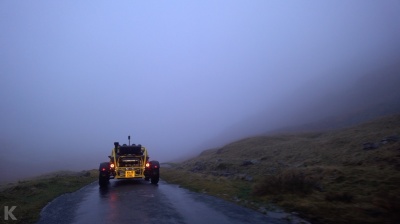
There was low cloud at the top of Wrynose but it cleared as the road dropped again to a plateau between the passes. At the end of this snaking ribbon was a cattle grid blocked by spray painted sheep; edging through them, we started on Hardknott. Hardknott is called the toughest drive in the country, but is it? The hairpins are steep and narrow and must be taken at speed to keep momentum on the way up, and with nerve on the way down, yet in the Nomad it was fun and exhilarating. To enjoy Hardknott you need an agile car with low-end grunt, grippy tyres and decent ground clearance. And being able to see exactly where the wheels sit on the road does help on the tight bends.
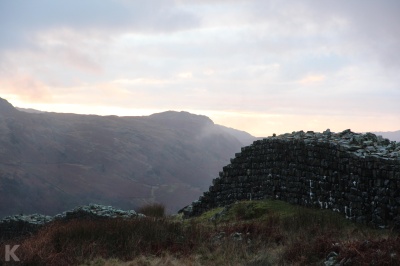
The descent from Hardknott is steep and the view to the coast uninterrupted. There are the remains of a Roman fort by the road and although the soldiers may have appreciated the view it's hard to imagine a more exposed spot to wear a toga. As with Wrynose, there was low cloud but through it we could see the sun setting and while our first reaction was wow, look at that, the second was uh-oh, we're in danger of losing the race. The satnav, usually quite accurate, predicted we would miss sunset by a few minutes but it hadn't allowed for a Nomad in a hurry down a country road. Dropping through the last hairpin we sped towards Drigg, which may seem like an odd place to end a road trip but hidden behind the Low Level Radioactive Waste Repository is a car park nestled in the dunes beside a huge and empty beach. The road to the dunes is straight, fast and just what I wanted as the seconds ticked down. We slid into the car park at 15:51, exactly at sunset and happy to call it a draw.

|
Whitby to Drigg route for GPS |
